Wedge shaped fitness accessory
Weber March 30, 2
U.S. patent number 10,960,260 [Application Number 16/676,257] was granted by the patent office on 2021-03-30 for wedge shaped fitness accessory. The grantee listed for this patent is Kurt Weber. Invention is credited to Kurt Weber.
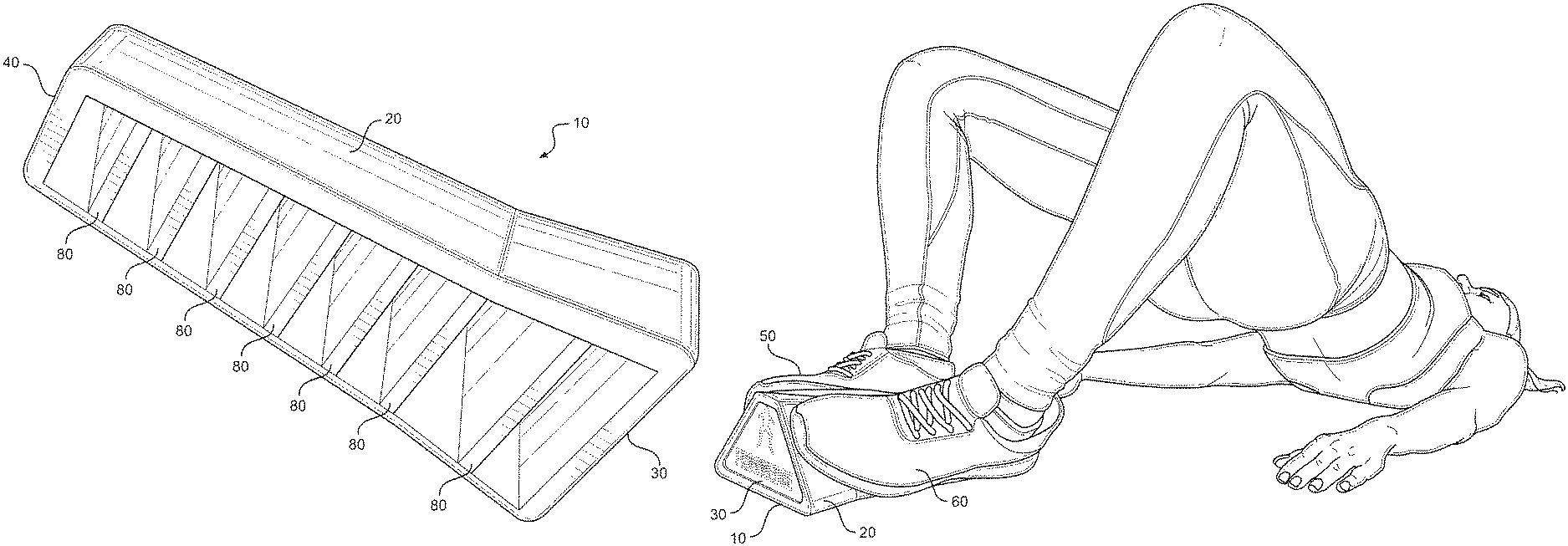
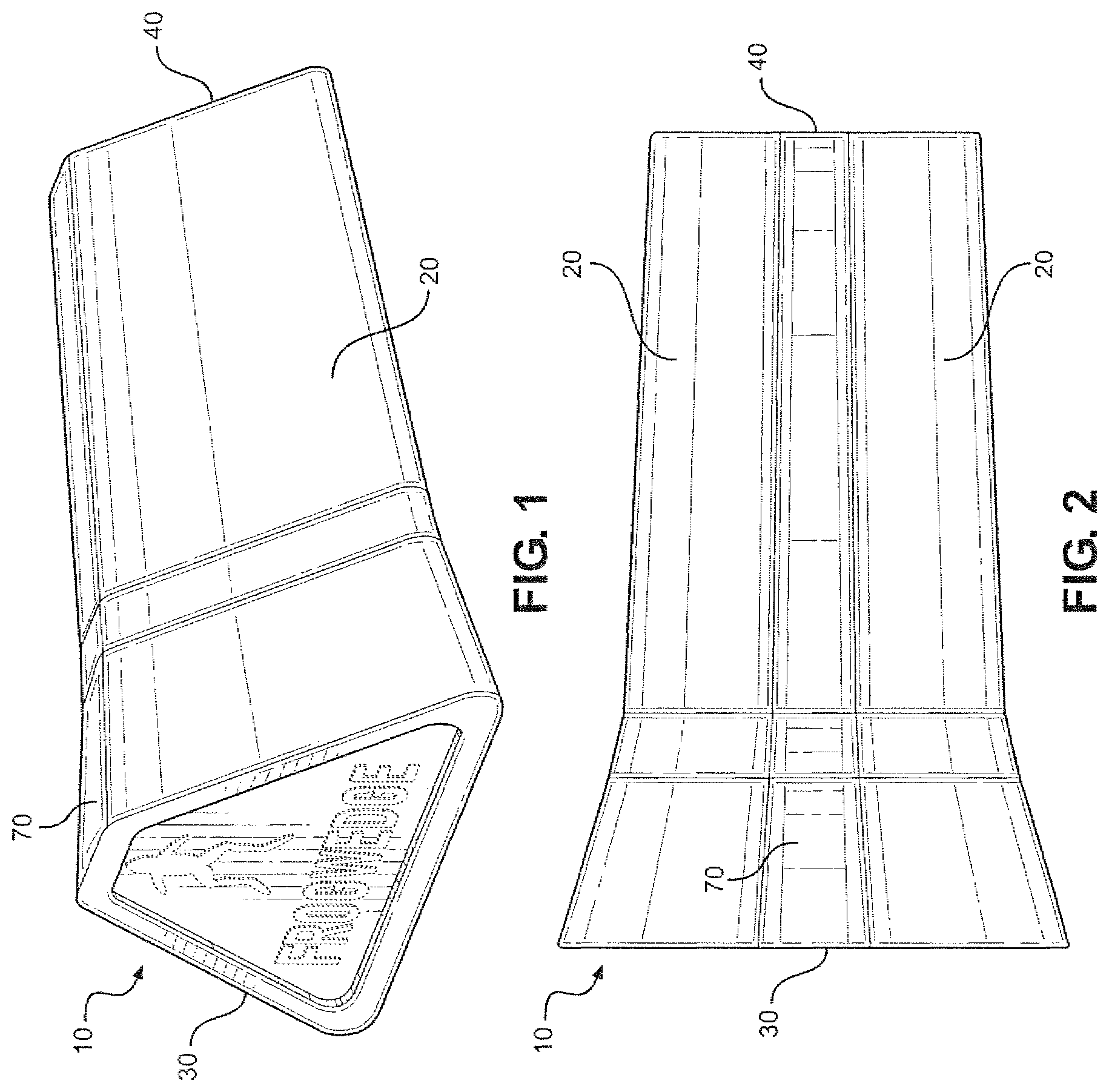
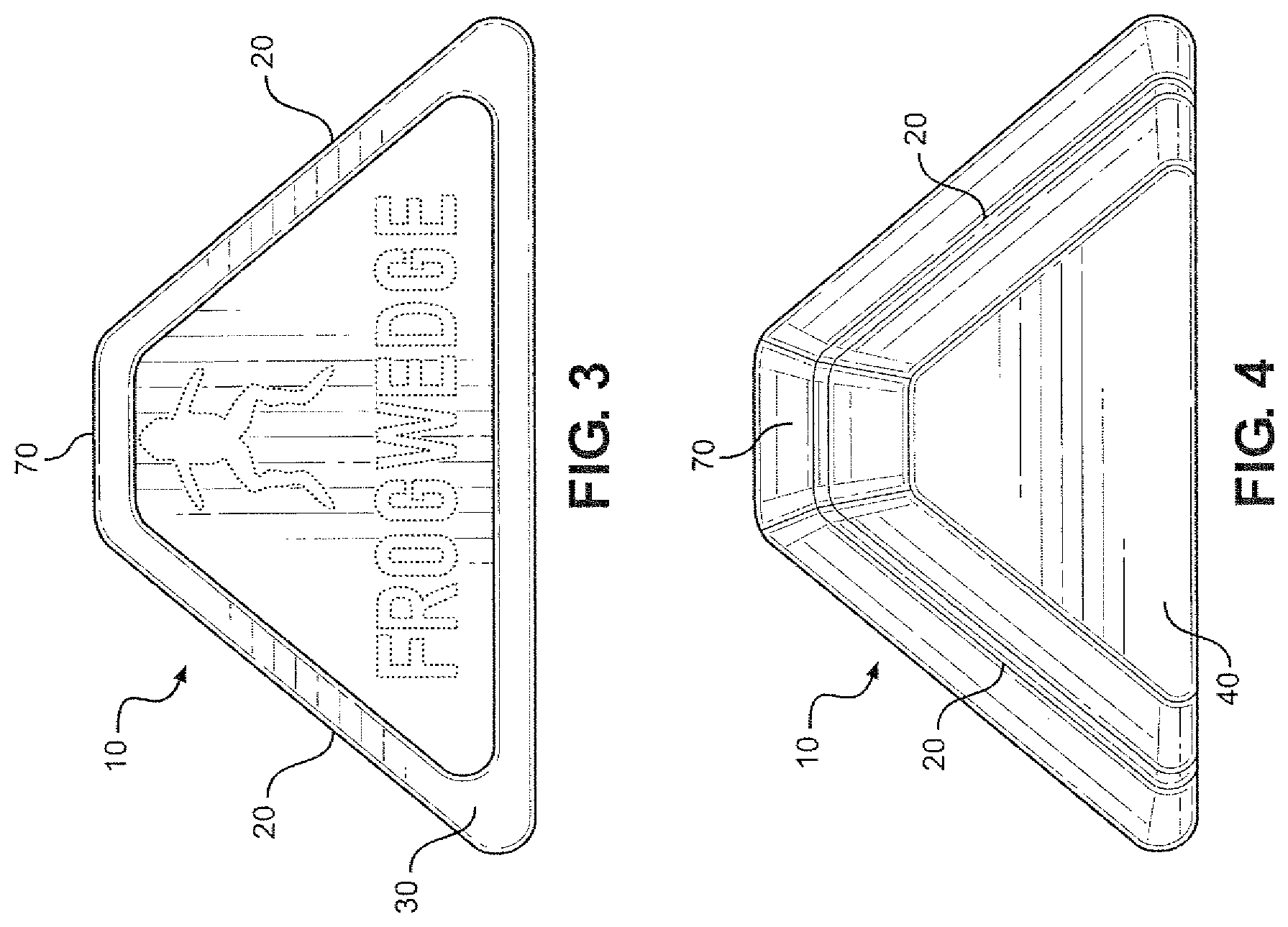
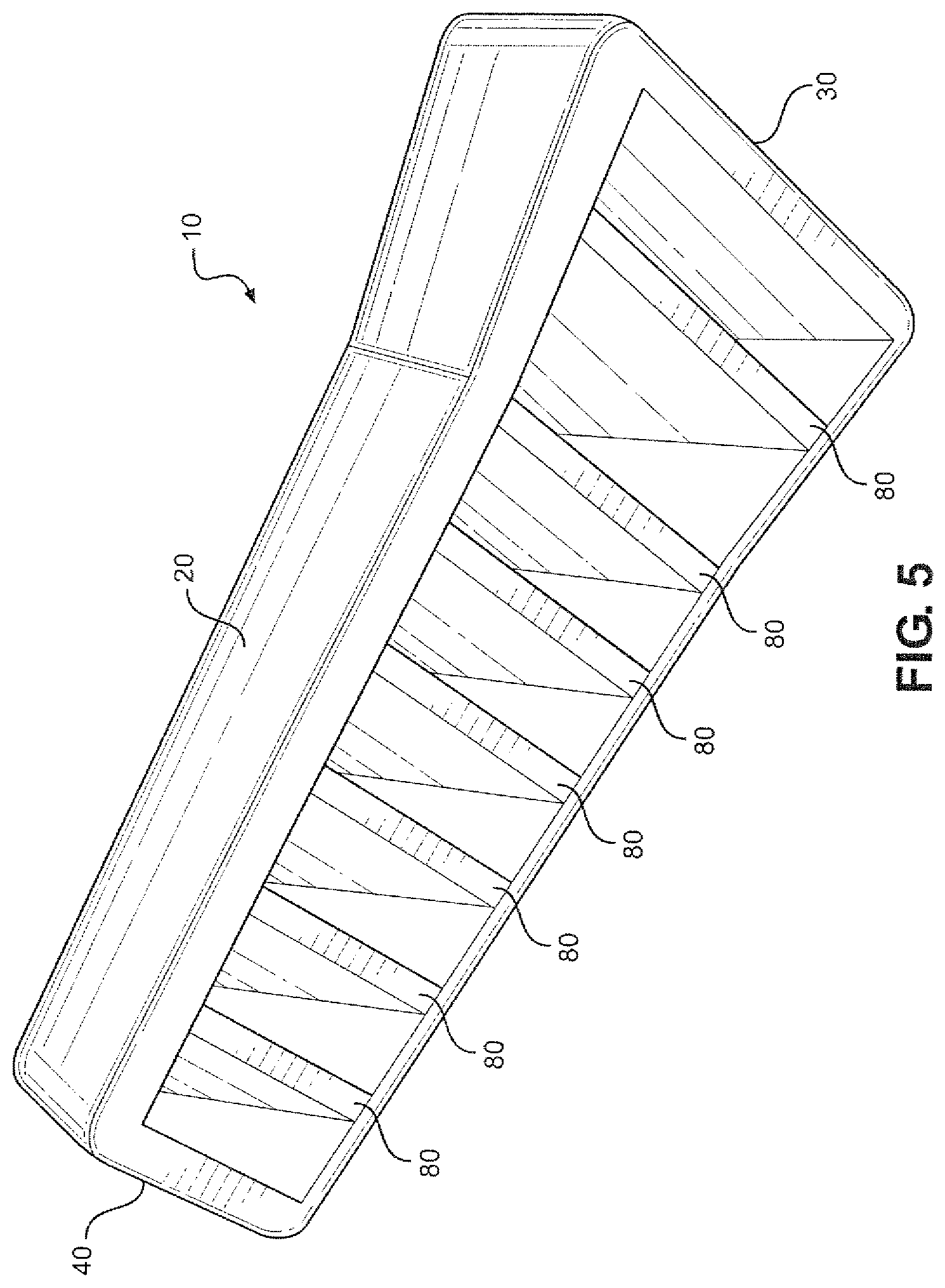
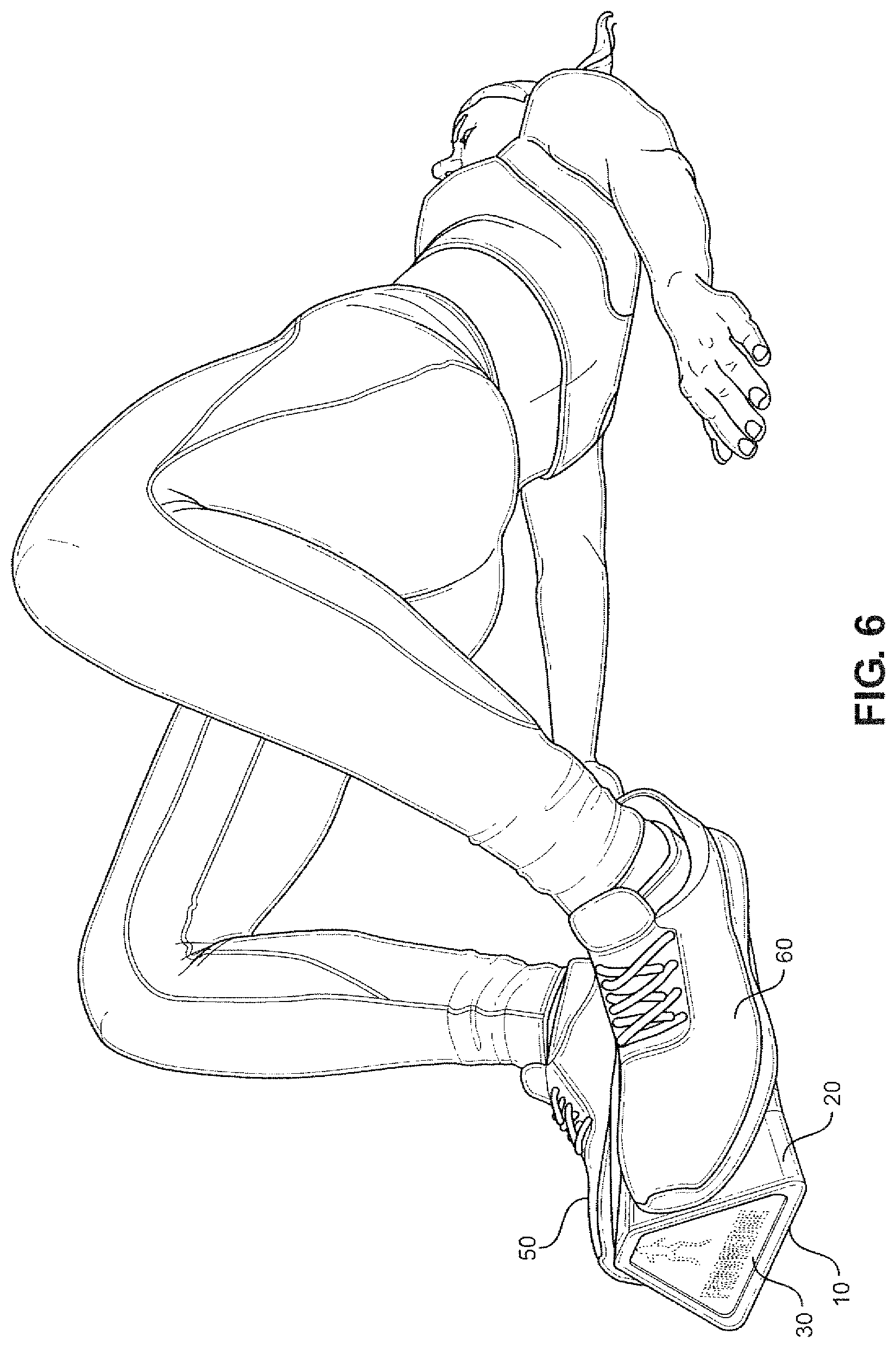
| United States Patent | 10,960,260 |
| Weber | March 30, 2021 |
Wedge shaped fitness accessory
Abstract
A fitness accessory for improving positioning and form during a frog pump exercise may include a wedge shaped device. The wedge shaped device may include a base; a top opposite the base; a pair of angled side walls connecting the base and the top; a first smaller end closing a first end of the wedge shaped device; and a second larger end closing a second end of the wedge shaped device. The device may taper from a larger width at the second end to a smaller width at the first end.
| Inventors: | Weber; Kurt (Costa Mesa, CA) | ||||||||||
|---|---|---|---|---|---|---|---|---|---|---|---|
| Applicant: |
|
||||||||||
| Family ID: | 1000004457585 | ||||||||||
| Appl. No.: | 16/676,257 | ||||||||||
| Filed: | November 6, 2019 |
Related U.S. Patent Documents
| Application Number | Filing Date | Patent Number | Issue Date | ||
|---|---|---|---|---|---|
| 62768264 | Nov 16, 2018 | ||||
| Current U.S. Class: | 1/1 |
| Current CPC Class: | A63B 23/04 (20130101); A63B 21/4039 (20151001); A63B 2208/0252 (20130101) |
| Current International Class: | A63B 21/00 (20060101); A63B 23/04 (20060101) |
References Cited [Referenced By]
U.S. Patent Documents
| 2931510 | April 1960 | Buck |
| 2981318 | April 1961 | Lincoln |
| 3262134 | July 1966 | Bramble, Jr. |
| 3389411 | June 1968 | Emery |
| 3532336 | October 1970 | Baker |
| 4265232 | May 1981 | Stonich |
| 4392489 | July 1983 | Wagner, Sr. |
| 5137333 | August 1992 | Chee |
| 5476105 | December 1995 | Toth |
| 6154904 | December 2000 | Ehredt |
| 6371894 | April 2002 | Hill |
| 6881179 | April 2005 | Mostardi |
| 7278987 | October 2007 | Solazzo |
| 7452313 | November 2008 | Endelman |
| RE43981 | February 2013 | Endelman |
| 8376920 | February 2013 | Anderson |
| 9084704 | July 2015 | Oberst |
| 9539468 | January 2017 | Nagasaka |
| D824467 | July 2018 | Rademacher |
| 10130836 | November 2018 | Madion |
| 10251808 | April 2019 | Theis |
| 2005/0020417 | January 2005 | Gary |
| 2007/0117695 | May 2007 | Endelman |
| 2007/0173391 | July 2007 | Edwards |
| 2012/0260428 | October 2012 | Franklin |
| 2014/0189955 | July 2014 | Alletto, Jr. |
| 2014/0256525 | September 2014 | Mueller |
| 2015/0025606 | January 2015 | Davis |
| 2016/0000242 | January 2016 | Campagna |
| 2016/0106225 | April 2016 | Ham |
| 2016/0152168 | June 2016 | Ito |
| 2017/0172331 | June 2017 | Publicover |
| 2017/0246719 | August 2017 | Pellenc |
| 2018/0008064 | January 2018 | Dudonis |
| 2018/0214327 | August 2018 | Stokesbary |
| 2019/0053648 | February 2019 | Santizo |
| 2019/0313817 | October 2019 | Morden |
| 2019/0365553 | December 2019 | Drivere |
| 2020/0100606 | April 2020 | Ganji |
| 2020/0214480 | July 2020 | Haney |
| 2020/0294401 | September 2020 | Kerecsen |
| 2020/0337479 | October 2020 | Zurek |
Attorney, Agent or Firm: Plager Schack LLP Plager; Mark H. Verryt; Kara
Parent Case Text
RELATED APPLICATION
This application claims priority to provisional patent application U.S. Ser. No. 62/768,264 filed on Nov. 16, 2018, the entire contents of which is herein incorporated by reference.
Claims
What is claimed is:
1. A fitness accessory for improving positioning and form during a frog pump exercise, the fitness accessory comprising: a wedge shaped device comprising: a base; a top opposite the base; a pair of angled side walls connecting the base and the top; a first smaller end closing a first end of the wedge shaped device; and a second larger end closing a second end of the wedge shaped device, wherein the device tapers from a larger width at the second end to a smaller width at the first end; wherein the top and the base extend between the angled side walls and the first and second ends; wherein the top is narrower than the base along an entire length of the wedge-shaped device; wherein an interior of the device is hollow; a plurality of support ribs positioned within the hollow interior, said support ribs extending between and connected to the angled side walls.
2. The fitness accessory of claim 1, wherein the at least one support rib extends along a width of the hollow interior.
3. The fitness accessory of claim 1, wherein the top has a smallest width proximate to the first smaller end and a largest width proximate to the second larger end.
4. The fitness accessory of claim 1, wherein an outer surface of the device comprises a gripping material.
Description
BACKGROUND
The embodiments described herein relate generally to fitness accessories, and more particularly, to a wedge-shaped fitness accessory to enhance glute activation and ergonomics of the frog pump exercise.
The traditional frog pump exercise places the ankles in a compromised position with the soles of the feet together and limits the resistance capable of being used due to ankle stress.
Therefore, what is needed is a device designed to allow for proper foot, ankle, knee, and hip alignment during the frog pump exercise while simultaneously improving safety and effectiveness of the exercise.
SUMMARY
Some embodiments of the present disclosure include a fitness accessory for improving positioning and form during a frog pump exercise. The accessory may include a wedge shaped device. The wedge shaped device may include a base; a top opposite the base; a pair of angled side walls connecting the base and the top; a first smaller end closing a first end of the wedge shaped device; and a second larger end closing a second end of the wedge shaped device. The device may taper from a larger width at the second end to a smaller width at the first end.
BRIEF DESCRIPTION OF THE FIGURES
The detailed description of some embodiments of the invention is made below with reference to the accompanying figures, wherein like numerals represent corresponding parts of the figures.
FIG. 1 is a perspective view of one embodiment of the present disclosure.
FIG. 2 is a top view of one embodiment of the present disclosure.
FIG. 3 is a front view of one embodiment of the present disclosure.
FIG. 4 is a back view of one embodiment of the present disclosure.
FIG. 5 is a bottom perspective view of one embodiment of the present disclosure.
FIG. 6 is a perspective view of one embodiment of the present disclosure, shown in use.
DETAILED DESCRIPTION
In the following detailed description of the invention, numerous details, examples, and embodiments of the invention are described. However, it will be clear and apparent to one skilled in the art that the invention is not limited to the embodiments set forth and that the invention can be adapted for any of several applications.
The device of the present disclosure may be used as a fitness accessory and may comprise the following elements. This list of possible constituent elements is intended to be exemplary only, and it is not intended that this list be used to limit the device of the present application to just these elements. Persons having ordinary skill in the art relevant to the present disclosure may understand there to be equivalent elements that may be substituted within the present disclosure without changing the essential function or operation of the device.
a. Base
b. Top
c. Angled Walls
d. Tapered Shape
The various elements of the present disclosure may be related in the following exemplary fashion. It is not intended to limit the scope or nature of the relationships between the various elements and the following examples are presented as illustrative examples only.
By way of example, and referring to FIGS. 1-6, some embodiments of the invention include a fitness accessory 10 for improving positioning and form during a frog pump exercise, the fitness accessory 10 comprising a wedge-shaped device with a base, a top 70 opposite the base, a pair of angled side walls 20 connecting the base and the top 70, a first smaller end 40 closing a first end of the wedge-shaped device, and a second larger end 30 closing a second end of the wedge-shaped device, wherein the device tapers from a larger with at the second end to a smaller width at the first end. As shown in the Figures, the width may flare outwards proximate to the second larger end 30.
In embodiments, the base may be larger in size than the top 70, wherein the top 70 may be comparatively narrow as comparted to the remainder of the device. Moreover, the top 70 may have a smallest or narrowest width proximate to the first smaller end 40 and a largest or widest width proximate to the second larger end 30. As shown in the Figures, each of the first smaller end 40 and the second larger end 30 may be substantially triangle shaped with a flattened top angle.
Some embodiments of the fitness accessory 10 of the present disclosure may be a solid, unitary piece. Alternatively, as shown for example in FIG. 5, an interior of the device may be substantially hollow. In embodiments with a hollow interior, the device may further comprise at least one support rib 80 extending the width (and optionally length) of the interior, such that the at least one support rib 80 provides additional strength to the accessory 10.
The fitness accessory 10 of the present disclosure may comprise any desired or suitable materials. For example, the fitness accessory 10 may comprise high-density rubber. Optionally, an outer surface of the fitness accessory 10 may comprise a gripping surface or have a gripping material layer applied thereto.
To use the device of the present disclosure, the user may lie down and place the fitness accessory 10 between his or her right foot 50 and left foot 60, as shown in FIG. 5, with the soles of the feet 50,60 on the angled sidewalls 20 and the second larger end 30 positioned toward the user's toes. To use the accessory 10, the user may press his or her feet 50, 60 into the accessory 10, thrusting the hips into the air, which completed the frog pump, hip thrust, or glute bridge exercise.
Experimental Data:
Exercises were completed both with and without the fitness accessory 10 of the present disclosure, and the percent activation of both the gluteus maximus and the gluteus medius were measured. Specifically, electrodes were attached to two muscles, the gluteus maximus and the gluteus medius, on a subject. The subject then laid down and performed a regular hip bridge exercise with feet flat on the ground with a technician's hands pressing on the subjects hips to establish a maximal voluntary contraction (MVC). The subject then performed the regular hip bridge and a frog bridge without the resistance from the technician's hands.
Data was calculated by comparing the MVCs (100%) with the body weight (BW) activation. The results are shown below, wherein the first row of data is the actual raw value of BW activation and the percent activation is relative to the MVC established at the beginning.
TABLE-US-00001 Glute Bridge without Fitness Accessory Frog Pump with Fitness Accessory Muscle Gluteus Maximus Gluteus Medius Gluteus Maximus Gluteus Medius BW activation 0.044 0.024 0.059 0.024333 Percent 33.6% 34.3% 45.0% 34.8% Activation
For the gluteus maximus, the glute bridge activated 33.6% of the 100% MVC, while the wedge bridge (with the fitness accessory) activated 45% of the 100% MVC. As such, using the fitness accessory of the present disclosure provided 34% better activation of the gluteus maximus. Thus, as shown by the above data, using the fitness accessory of the present disclosure results in increased percent activation of the glutes during exercises.
Additionally, in the past, while the frog position pump exercise activates more muscle, the potential MVC for the traditional hip bridge was much greater than a feet-together frog pump because of stability issues. However, using the fitness accessory of the present disclosure closes the biomechanical gap, not only providing for superior activation, but also for more stable positioning needed for a much greater MVC as well.
The above-described embodiments of the invention are presented for purposes of illustration and not of limitation. While these embodiments of the invention have been described with reference to numerous specific details, one of ordinary skill in the art will recognize that the invention can be embodied in other specific forms without departing from the spirit of the invention. Thus, one of ordinary skill in the art would understand that the invention is not to be limited by the foregoing illustrative details, but rather is to be defined by the appended claims.
* * * * *
D00000

D00001

D00002

D00003

D00004

XML
uspto.report is an independent third-party trademark research tool that is not affiliated, endorsed, or sponsored by the United States Patent and Trademark Office (USPTO) or any other governmental organization. The information provided by uspto.report is based on publicly available data at the time of writing and is intended for informational purposes only.
While we strive to provide accurate and up-to-date information, we do not guarantee the accuracy, completeness, reliability, or suitability of the information displayed on this site. The use of this site is at your own risk. Any reliance you place on such information is therefore strictly at your own risk.
All official trademark data, including owner information, should be verified by visiting the official USPTO website at www.uspto.gov. This site is not intended to replace professional legal advice and should not be used as a substitute for consulting with a legal professional who is knowledgeable about trademark law.